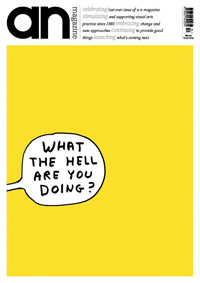June will see publication of the last ever issue of a-n Magazine after 32 years, making space for new programmes from a-n The Artists Information Company. Susan Jones reflects on changing times

Imagine – it’s 1980 and a group of artists gathered together – courtesy of regional arts funders – to consider how to improve information for artists. But without personal computers, Internet, web publishing, mobile telephone and social media how could artists then get to hear all about awards, prizes, teaching jobs, be consulted on arts policy and find affordable studios and art suppliers?
Thus was born ‘Artists Newsletter’ – first issue September 1980 – 18 black and white pages, classified ads on the front, with the launch editorial exclaiming: “We will be an open line of communication.… clearing house for practical information and the raising of issues of significance to artists. Our format is not fixed and will adapt and change…”
Amongst the first features were an innovative visual map exposing how arts funding trickled down into practitioners’ hands, another a petition demanding “fair treatment for women artists and those working in ‘alternative media’” by the then Arts Council of Great Britain (ACGB). Artists were hungry for such otherwise inaccessible information and immediately took the newsletter to their hearts. Within two years, it was earning 75% of turnover from subscriptions (£3 a year) and selling adverts (£450–£800 worth an issue). Although funded by four northern arts associations, readership (and content) from the outset reflected the whole of the UK. a-n was soon invited into ACGB’s visual arts portfolio, supported to publish a portfolio of artists’ handbooks, directories, guides and model contracts.
Always biting the hand that fed us, raising important arts funding issues continued to be a core theme through the 1990s: “The problem with arts bureaucrats is that they don’t understand consultation, so they set up structures that are long-winded and ineffectual. Consultation isn’t about representative structures to direct decision-making. It’s about dialogues that critique and inform decision-making.” In 1998 we reported on the Arts Council’s decision to disband artform peer panels – too expensive and time-consuming they said – leaving funding decision-making predominantly to arts officers, without benefit of insights from artform experts, those with genuine knowledge that comes from working at the coal face. It seemed to us to be a peculiarly short-sighted way to foster collective energy and action essential to visual arts development and we said so.
We’d always tracked and supported the hard-won arguments for Exhibition Payment Right* – fees paid to artists by galleries for public exhibition of work. But arts funders later swept this away (without consultation), replacing it with schemes like the 2000 Year of the Artist, reliant on a programme of residencies, that funders believed would better raise the status of artists, increase public awareness of the contribution of creativity to society and generate (more) opportunities and partnerships for artists to initiate their own projects. But the Arts Council’s own evaluation of the Year showed only 1,700 artists (across all artforms) directly benefited. Our research revealed that during 2000: “Residencies accounted for 4% of the value of all opportunities, with the average fee to selected artists dropping to £1,738 (from £3,321 ten years ago).”**
Since 2003, the printed a-n Magazine has formed only one part of what we produce and are known for. We generated the NAN (Networking Artists Networks) initiative and AIR (Artists Interaction and Representation). We’ve delivered a host of professional development activity, most recently through the A+ partnership with Artquest. The early themes continue to run throughout our work – we champion the artist-led, the value of collaborative relationships, advocate for good practice, we provide tangible support for artists’ networking and professional development and last but not least – we are at the forefront of ensuring debate and consultation on the development arts policy.
Fortunately, there are more mechanisms now to create and sustain the conversations and exchange. Our web publishing exposed how artists’ organisations fared in the March 2011 Arts Council England (ACE) National Portfolio Organisation settlement in ‘Ladders for development’, ACE’s 2006 visual arts strategy and what it had it cost in ‘Understanding Turning Point’ and funding to individual artists – a subject examined in a very early in Artists Newsletter exposed in ‘A fair share’. AP and The Guardian are amongst those who now relay on our messages, widening the audiences and the debates. Rather than wait for an invitation, artists start up their own blogs and become part of a lively peer community, continuously discussing and showing. We have embraced social media in the delivery of our role, thus our recent ‘#copyrightgreyareas’ debate reached out to over 45,000 people in just two hours.
So what’s next for a-n then? Launching soon will be our dedicated web-based news platform with live-coverage, Twitter debates and fast-turnaround interviews. We’re phasing in a new members’ website, integrating tools for supporting collaboration, development and making, funding and finding of work in the visual arts. By the autumn, we’ll be providing more professional development opportunities for artists and arts freelancers with an established practice through the ‘Granted’ programme and providing targeted support for new graduates in this very challenging environment. These are the foundations for how we’ll deliver our mission in the future: stimulating and supporting visual arts practice and affirming the value of artists in society – no mission drift for us.
W www.a-n.co.uk/whats_next
* Artists’ rates of pay 1989–2004 http://bit.ly/hRBk2h
** Art work – Artists’ jobs and opportunities 1989-2003 http://bit.ly/j9XMtV




